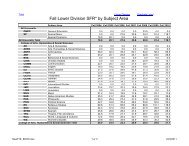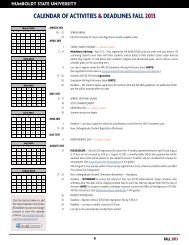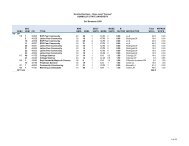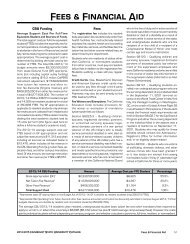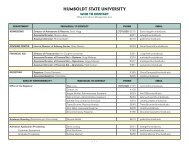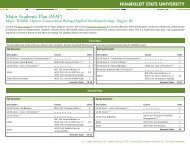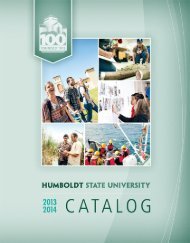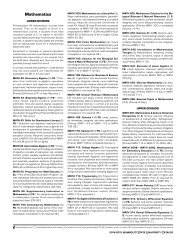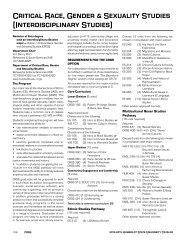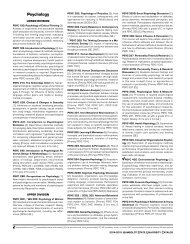2007-08 Academic Year - Humboldt State University
2007-08 Academic Year - Humboldt State University
2007-08 Academic Year - Humboldt State University
Create successful ePaper yourself
Turn your PDF publications into a flip-book with our unique Google optimized e-Paper software.
Units earned by examination will not count<br />
toward <strong>Humboldt</strong>’s residency requirement.<br />
Persons challenging courses must be enrolled<br />
as matriculating students.<br />
Class Level<br />
Students are classified according to the<br />
number of semester units completed:<br />
Freshmen<br />
Sophomores<br />
Juniors<br />
Seniors<br />
fewer than 30 units<br />
30 to 59.9 units<br />
60 to 89.9 units<br />
90 or more units<br />
Commencement<br />
Graduation ceremonies take place on the<br />
Saturday following spring semester final<br />
exams. Each college hosts its own ceremony.<br />
These are the only ceremonies taking place<br />
during the academic year.<br />
Credit by Examination<br />
<strong>Humboldt</strong> <strong>State</strong> grants credit for passing<br />
scores on external examinations such as<br />
advanced placement tests and some CLEP<br />
exams (see the chart in the Admissions<br />
Information section listed under Test<br />
Requirements). No more than 30 semester<br />
units of such credit may apply to a baccalaureate<br />
degree. Advanced placement<br />
credit is excluded from this limit.<br />
Students presenting scores of 3 or better<br />
on the advanced placement exams of the<br />
College Board may receive up to six semester<br />
units of college credit per exam. Students<br />
presenting scores of 5, 6, and 7 at Higher<br />
Level will receive six units of credit for the<br />
International Baccalaureate exam. Refer to<br />
the section titled ‘Advanced Placement Tests’<br />
to see how credit for specific exams will apply<br />
toward degree requirements.<br />
Credit for Non-collegiate<br />
Instruction<br />
<strong>Humboldt</strong> grants undergraduate degree<br />
credit for successful completion of noncollegiate<br />
instruction—either military or<br />
civilian—appropriate to the baccalaureate<br />
degree. Credit must be recommended by<br />
the Commission on Educational Credit and<br />
Credentials of the American Council on<br />
Education.<br />
For civilians, The National Guide to Educational<br />
Credit for Training Programs<br />
recommends the number of units allowed.<br />
Appropriate documentation of instruction/course<br />
work must be submitted to the<br />
registrar through the <strong>Academic</strong> Information<br />
and Referral Center before credit can be<br />
awarded.<br />
Military Credit. Students may earn credit for<br />
one year or more of active military service<br />
with an honorable discharge by filing a copy<br />
of their DD-214 with the Registrar’s Office.<br />
Students may earn credit for education and<br />
training courses completed in the military,<br />
based on recommendations by the American<br />
Council on Education. Students will need to<br />
submit appropriate documentation such as<br />
a military registry transcript, DD-295, or<br />
Verification of Military Education Training<br />
(VMET), to Veterans Enrollment Services in<br />
the Student & Business Services Building.<br />
Contact Veterans Enrollment Services to see<br />
about obtaining a military registry transcript<br />
or other VA forms, 826-6191.<br />
Credit Limitations<br />
Extension and Correspondence. Students<br />
may count no more than 24 semester units<br />
of extension or correspondence courses<br />
toward a bachelor’s degree. Note: These<br />
may not count toward the residency requirement.<br />
Open <strong>University</strong>. Students may count no<br />
more than 24 semester units of Open<br />
<strong>University</strong> / Special Session courses toward<br />
a bachelor’s degree. No more than eight<br />
units of Open <strong>University</strong> / Special Session<br />
courses can apply toward a master’s degree<br />
(provided these courses are on the candidate’s<br />
approved master’s program).<br />
Transfer Credit. No more than 70 semester<br />
units earned at an accredited community<br />
college may transfer to <strong>Humboldt</strong> <strong>State</strong><br />
(California Code of Regulations, title 5).<br />
No more than six units earned in intercollegiate<br />
athletics may count toward graduation<br />
requirements. No more than two units<br />
of intramural courses may count toward<br />
graduation.<br />
Credit/No Credit<br />
Mandatory Credit/No Credit. Some courses<br />
are offered only credit/no credit—no<br />
letter grades. These include activity courses,<br />
thesis projects, field projects, independent<br />
study courses, and specialized courses.<br />
Optional Credit/No Credit. In some courses,<br />
students choose between taking a letter<br />
grade or credit/no credit. A student choosing<br />
the credit/no credit option must do so by<br />
the 8th week of classes; otherwise she/he<br />
will receive a letter grade.<br />
Courses used to fulfill major requirements<br />
may not be taken on an optional credit/no<br />
credit basis. No more than 24 semester<br />
units of credit/no credit (mandatory and/or<br />
optional) taken at <strong>Humboldt</strong> <strong>State</strong> will count<br />
toward a bachelor’s degree.<br />
Graduate students can choose optional<br />
CR/NC only for courses not required by<br />
their approved program. No more than 1/3<br />
of master’s degree courses may be taken<br />
credit/no credit.<br />
Students may take only one optional CR/NC<br />
course per semester at <strong>Humboldt</strong> <strong>State</strong>.<br />
Evaluating Credit. For an undergraduate<br />
student, unclassified post-baccalaureate<br />
student, and second bachelor’s degree student<br />
credit is equivalent to a passing grade<br />
(A, B, C, or C-). No credit is equivalent to a<br />
D+ or lower. For a graduate student who<br />
is in a master’s degree program, or a credential-seeking<br />
student, credit is equivalent<br />
to a passing grade (A, B, or B-). No credit is<br />
equivalent to a C+ or lower.<br />
Disqualification<br />
(see <strong>Academic</strong> Standing)<br />
Double Major<br />
Students may earn a bachelor’s degree with<br />
two majors by completing the requirements<br />
for both programs. Although both majors appear<br />
on the permanent record, the student<br />
receives one degree.<br />
For information on pursuing two degrees,<br />
please see “Second Bachelor’s Degree.”<br />
Drop/Add<br />
(see Schedule Adjustments)<br />
Educational Leave<br />
(see Leave of Absence)<br />
Enrollment Limitations<br />
Undergraduate students are limited to 19<br />
units per semester. Any student anticipating<br />
the need to enroll for more than 19<br />
units should seek approval from his/her<br />
academic advisor.<br />
Full-time Status<br />
A normal course load is 15 units for undergraduates<br />
to ensure timely progress towards<br />
the bachelor’s degree. Undergraduates taking<br />
12 or more semester units, or graduate<br />
students taking nine or more semester<br />
units, are enrolled full-time for student verification<br />
purposes.<br />
Grading Symbols<br />
A — Outstanding achievement<br />
B — Very good, commendable achievement<br />
C — Satisfactory achievement<br />
<strong>2007</strong>-20<strong>08</strong> <strong>Humboldt</strong> <strong>State</strong> <strong>University</strong> Catalog<br />
<strong>Academic</strong> Regulations<br />
31



